Photos with this report (click to enlarge) | |||
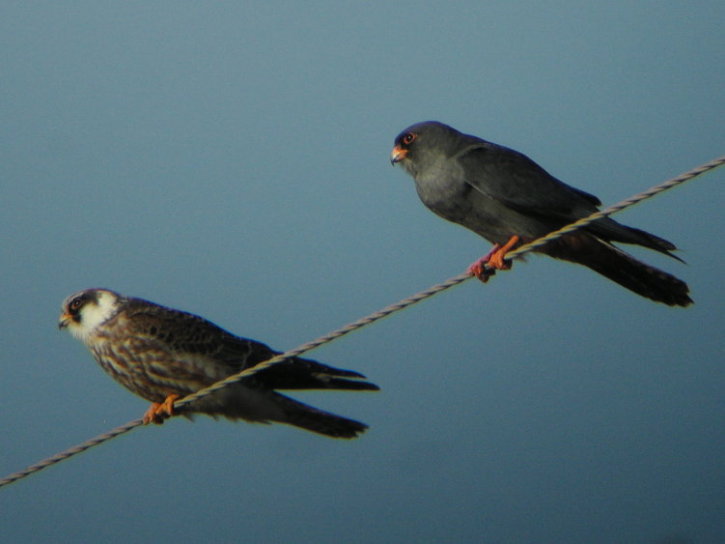 RED FOOTED FALCON |
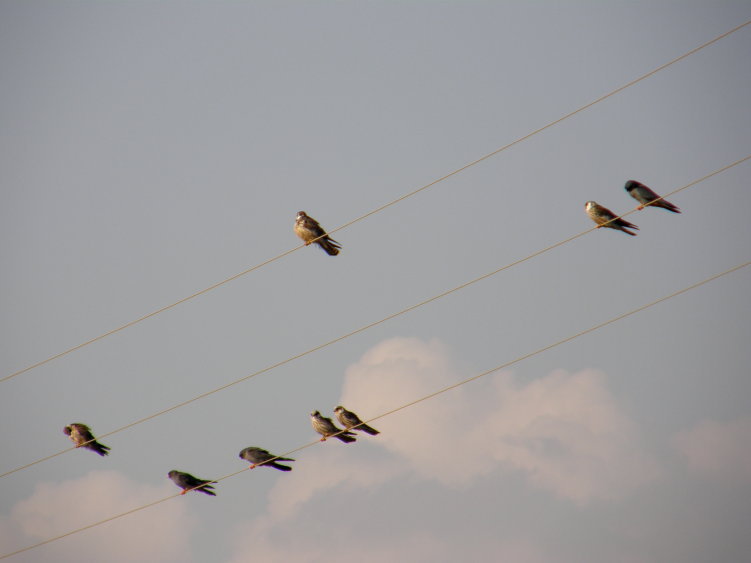 RED FOOTED FALCON |
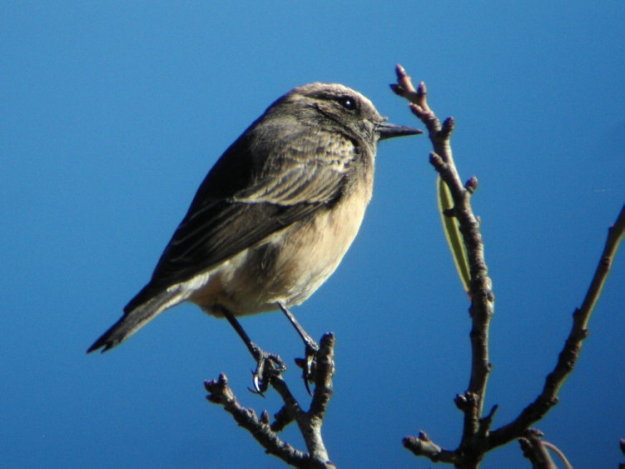 CYPRUS WHEATEAR |
|
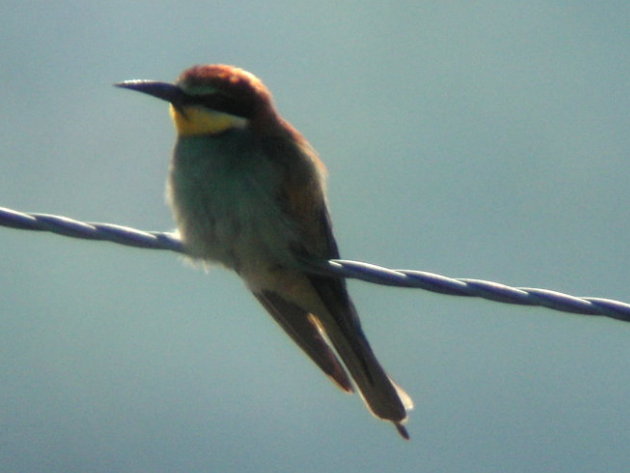 BEEEATER |
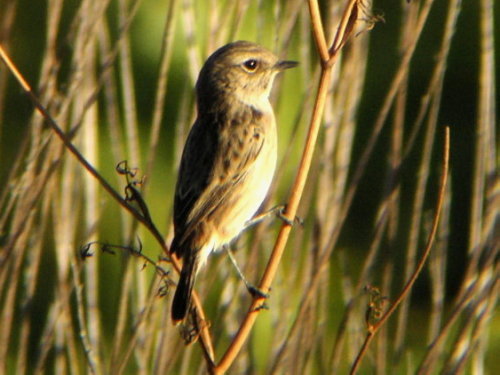 STONECHAT(FEM) |
||
During early October we were lucky enough to stay in Cyprus with friends, in the lovely village of Kala Chorio, which nestles in the foothills of the Troodos Mountain range. Kala Chorio stands at 600m above sea level with a beautiful rural landscape of rugged hillsides mixed with rough vegetation, orchards and vineyards. The weather was mostly fine and sunny, with temperatures in the high 20T’s except for in the evening when it was decidedly cooler, particularly towards the end of our break. The good weather was interrupted by thunder storms on the Wed and Thursday of the first week. Unfortunately however, this did not bring in the falls of migrants that one might have hoped for, at least not in the immediate vicinity.
Apart from local endemics which show fairly well, locating birds was generally like pulling teeth, which I continue to put down to the general “hunting” culture on the island. Two recent unfortunate stories back this up, one from our host who some weeks ago admonished two men for taking pot shots at Bee-eaters on the wires below his house, his attention having been drawn not so much by the gun fire but the sound of cartridge shot raining down on his metal roof. The second story of course relates to the widely reported Birdlife International story, “52 Red-footed Falcon –listed as Near-threatened by BirdLife - have been found shot at Phasouri in Cyprus, a well-known poaching 'black spot'. The finding has appalled conservationists throughout Europe, and has led to BirdLife Cyprus renewing calls for action on the issue”.(For those unfamiliar with this go to: http://www.birdlife.org/news/news/2007/10/cyprus_falcon_massacre.html) Ironically the birds featuring in these two cruel tales are amongst the most gregarious, benign and beautiful. It is quite likely that perhaps the whole seasons breeding effort of a group were wiped out in one go. We were lucky enough to see several groups of Red Foots, numbers of which varied; at Kala Chorio from single birds to 20+ and near Kolossi orange groves, parties of 10 – 30 birds.
Kala Chorio :
House Sparrow
Great Tit
Nightingale
Lesser whitethroat
Whitethroat
Blackcap
Cetti’s warbler
Cyprus Warbler
Cyprus wheatear
Stonechat
Spotted flycatcher
Bee-eater
Kestrel
Red-footed falcon
Short-toed Eagle
House Martin
Crag Martin
Swallow
Red-rumped swallow
Red-backed shrike
Crested lark
Tree pipit
Greenfinch
Goldfinch
Magpie
Chukar
White wagtail
Heard but not seen: Scops Owl
Akrotiri, Phassouri, Zakaki Pool & Kolossi 13/10/07
For the second time this year (the first being in June), visits to Akrotiri and Phassouri reedbeds again proved disappointing in terms of birding opportunities. The salt lake appeared dry and along with surrounding areas, it was not very accessible at this time of year. Although at the Forest Nursery site there were plenty of warblers about, nothing lingered long enough for us to get a good fix on them. Contrary to this though was our sighting of good numbers of Red Footed Falcons, particularly those that lighted on the wires on the main road through the orange groves, back to Kolossi, during late afternoon. We stopped for a good half to watch them hawking over the trees, whilst at one point there were a dozen birds on the wires and at least 20 more in the air.
At Phassouri reedbeds, a large flock of bee-eaters passed over while an adult male marsh harrier was being mobbed by swallows. The coastal road to Episkopi Bay also proved unfruitful, since we were unable to add to our tally further with anything except the odd stonechat, swallows, martins and a number of unidentified pipits.
By the time we got to Zakaki Marsh and Pools, the sun was against us. Views of waders on the salt marsh and pools running parallel to Lady Mile Beach were difficult against the setting sun.
Akrotiri
ChiffChaff
Yellow Wagtail
Feral pigeon
Collared Dove
Yellow wagtail
Phassouri Reed Beds
Cattle Egret
Lapwing
Mallard
Marsh Harrier (adult male)
Yellow Wagtail
Stonechat
House Martin
Swallow
Crested Lark
Hooded Crow
Spanish Sparrow
Goldfinch
Bee-eaters (flock of 50+)
Zakaki Pools & Lady Mile Beach
Grey heron (12)
Slender-billed gull (4)
Yellow-legged gull (juv)
Moorhen
Coot (numerous)
Snipe
Marsh Harrier (Juv)
Mallard (numerous)
Little grebe (2)
Kentish plover ( 6)
Little stint (1)
Hooded Crow
Kolossi
Red-footed falcons (mixed flock of adult and juvenile birds)
Pissouri / Melanda Beach and Pafos Headland 14/10/07
We decided to head off towards the coast today, calling at the beautiful Pissouri Bay for a coffee ( the only bird of note that we saw was a Kestrel on a telegraph pole in the village) then on down a track off the B6, down to Melanda Beach. It struck me earlier this summer that with its vista of open fields and small vineyards, it might be a good for migrants. Although again it was disappointing, I would still think it worth a try in the spring. We did however have good views of several whinchats, red backed shrike and a wheatear that we struggled to identify.
At pull in near Aphrodite’s Rock, several Jackdaws flitted about the cliffs.
Following a nice fish lunch at Pafos harbour , we decided to take in the Mosaic Site and headland. A Sardinian warbler flitted in the scrub by one of the paths and a fan tail warbler briefly appeared on a stalk of thistle. As it rapidly clouded over and began to rain, a juvenile red backed shrike was in view near the ruins. Following a heavy shower that lasted about ten minutes, a Kestrel decided to take a bath in a puddle only to be harassed as it did so by two hooded crows.
A walk around the headland that initially showed much promise, only revealed Crested Lark, Stonechat and a large cloud of small birds wheeling against the sunlight, unfortunately making them impossible to identify.
Pissouri / Melanda Beach
Red-backed shrike
Whinchat
Magpie
Spanish Sparrow (flock)
Pafos Headland
Kestrel
Hooded crow
Red-backed shrike
House sparrow
Spanish sparrow
Sardinian warbler
Swallow
Fan-tailed warbler
Stonechat
Crested Lark
Jackdaw
Troodos and the Kalidonia Falls 15/10/07
Finally we headed off for a mountain trek, around the Kalidonia Falls nature trail. Although we did not see the eagles and vultures that we had hoped for on this walk, we were rewarded with spectacular views of the island. The circular walk is about 10k in length and is not for the feint hearted. For much of the latter part the path winds its way down the mountain, following the screes on the pine laden southerly slopes of the Troodos range. Fortunately the weather remained fair, but cool and breezy.
Near the radar “golf balls” perched on top of the mountain, a peregrine buzzed by as six chattering jays broke cover. A wren ticked away in the undergrowth and further down in the valley a short toed treecreeper was foraging the cones of a pine tree along with a family of coal tits.
Kalidonia Falls (1600- 2000m)
Peregrine
Coal Tit
Jay
Blackbird
Wren
Short-toed treecreeper
Chaffinch
Goldfinch
Bee-eaters (flock of 50+)
Blackbird
Blackcap
Cattle Egret
Cetti’s warbler
Chaffinch
Chukar
Coal Tit
Crag Martin
Crested lark
Cyprus Warbler
Cyprus wheatear
Fan-tailed warbler
Goldfinch
Great Tit
Greenfinch
Hooded Crow
House Martin
House Sparrow
Jackdaw
Jay
Kestrel
Lapwing
Lesser whitethroat
Magpie
Mallard
Marsh Harrier (adult male)
Nightingale
Peregrine
Red-backed shrike
Red-rumped swallow
Red-footed falcon
Sardinian warbler
Short-toed Eagle
Short-toed treecreeper
Spanish Sparrow
Spotted flycatcher
Stonechat
Swallow
Tree pipit
Whinchat
White wagtail
Whitethroat
Wren
Yellow Wagtail